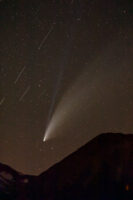“I saw some flashing lights in a dark night sky, and they appeared to not move; what are they?”
I frequent several online sources of astronomy information where questions are posted, and it is not at all uncommon to see this particular question. Of course I cannot answer definitively for any specific circumstance (unless significant images are collected), but I can answer for data which I’ve collected, and I’ve collected quite a bit over the last few years. I’ve spent countless hours watching the night sky, typically from very dark sky locations (Bortle 1-3), which allows one to see things that would otherwise be obscured in light-polluted skies. I almost always see ‘flashers’ when I go out to shoot, often multiple times per night, and I’ve observed that they typically follow two different patterns:
- A random bright flash that may/may not be accompanied by additional flashes of similar intensity, emanating from the same part of the sky (i.e. appear to be stationary); and
- An initial bright flash, followed by subsequent flashes of decreasing intensity, decreasing over the course of about 2 minutes; these flashes move a bit in the sky, but not as much as most LEO (low earth orbit) satellites would move, and can thus be perceived as stationary. The flash pattern of these are fairly consistent, but I’ve not yet researched what type of satellite these are.
Admittedly, the particular example I use below occurred later at night and was captured with a camera I’d remotely set up for a time-lapse, so I didn’t actually witness these flashes (nor do I know if they were visual with scotopic human vision). The primary intermittent flashes in this video that got my attention while editing are nearly exactly in the center of this crop of the upper right corner of the base image (below) and would surely have been visible to an observer, as the points of light exhibit the comatic aberration characteristics of the lens used (in this case the Sigma 28mm f/1.4 Art). The flashes occur periodically (about every 11 frames, or every 2m 34s), indicating likely rotation of an out-of-control satellite. The timelapse video presented below is cropped from the upper right corner of this view, where the camera was pointing roughly south, in this case toward Mt. Sopris, Colorado:

Geosynchronous Satellites
The part of the sky being imaged contained a bit of the geosynchronous satellite belt, a ‘line in the sky’ where mostly communications satellites reside at an altitude of approximately 35000+ kilometers (22000 miles). At this altitude most geosynchronous satellites will remain in the same part of the sky, and will orbit the earth exactly once per day, returning the the exact same spot every 23h 56m 4s. These satellites can be discovered in timelapse video where the starfield moves, but points of light arranged in a rough ‘line’ remain fixed in position (in this case, I was not using a star-tracker, which I typically do not for night timelapses). These geosynchronous satellites (geosats) do move a bit and their orbits do slowly decay, requiring occasional firing of thrusters to remain ‘on station’. At their end of life when they still have a bit of fuel left, they are required to be de-orbited to a higher ‘graveyard orbit’, to prevent disruption to the existing geosynchronous satellite array, positions of which are limited, controlled and coveted. This view was looking south-southwest, and includes an area of the geosynchronous satellite belt which you can see as the arc of green dots (albeit one that is less populated than most of the rest of the belt):
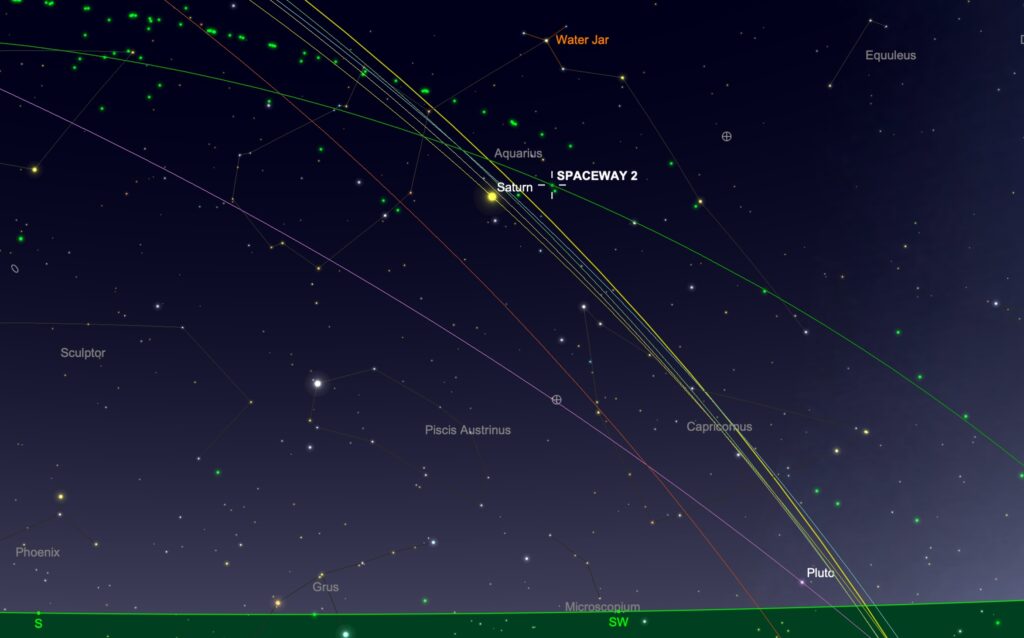
So, for those of you out there interested in non-moving ‘flashing lights in the night sky’, what follows illustrates one instance of these flashes, presented in three different ways, in order to better visualize what is going on. The video and images also highlight how busy this part of the night sky is, and when captured well from a dark sky, illustrates several different types of satellite in addition to the geosats, most of which are faint and not generally visible using scotopic human vision.
Almost in the exact center of the video below you will see the ‘flashing’ exhibited by this satellite, possibly non-operational (tumbling); there is really no way to know without investigating exactly which satellite it is, and then determining whether it is operational or has been decommissioned (some communications satellites do rotate). There are several other geosats in the video, and can be seen by noting the relatively motionless ‘dots’ that move little through the video. That being said, one satellite in particular moves in a very odd manner (from right edge, up and to the left more aligned with the geosat belt, and appears to ‘accelerate’ as it nears the belt); I would guess that this is a spacecraft in a highly-elliptical orbit (see ‘molniya’ orbit for an example):
Let’s back up and keep in mind what we are seeing here, that is, the camera fixed in position, and watching the stars move across the field of view due to the rotation of the earth. As noted previously, you can see several dots of light that mostly remain in place; again, these stationary points of light are the geosychronous satellites, although as noted above, they are not always completely stationary.
Now we’ll look at this another way, by presenting each frame and compositing a selection of them (using Blend:Lighten in Photoshop), creating a classic star-trail image:

Compiling data in this way makes ‘deviations from the norm’ more obvious, e.g. anything that is moving in a direction different than the rotation of the earth becomes more apparent, and it also makes geosynchronous satellites show up as single points of light, as they have not moved during the course of the multiple exposures. In the case of this segment of time, there is one significant deviation, and it looks like something moving nearly perpendicularly to the star trails (upper right corner, circled). Here is a crop of that area:
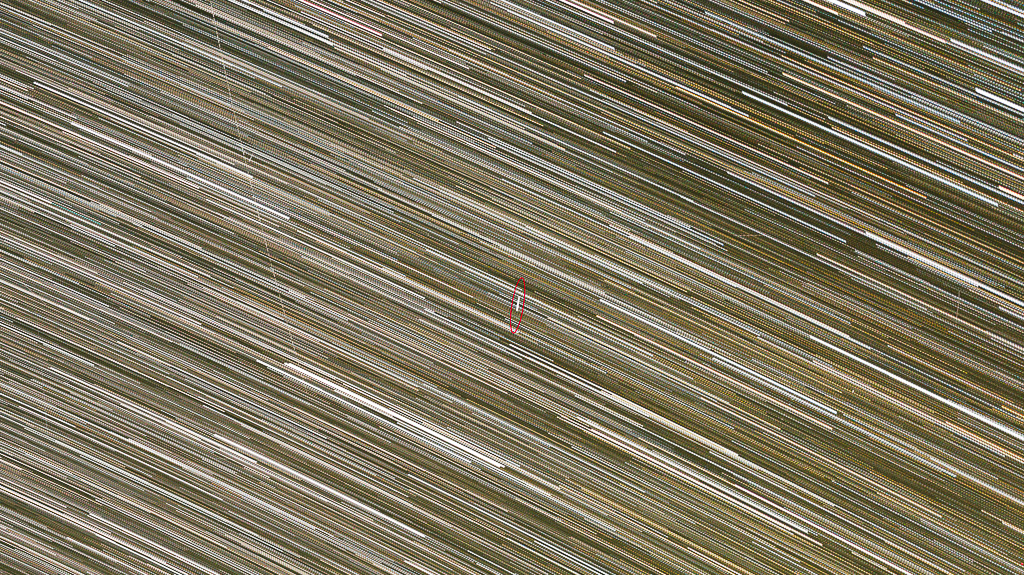
Circled above in red is the ‘flashing’ satellite in question, and you can see that it has moved a bit (nearly perpendicular to the star trails), which is a bit unusual for an operational communications satellite (aside from re-positioning). The trail on the upper left part of the image is a satellite probably in medium earth orbit (possibly a GPS satellite); for a given exposure time, the length of the trail is dependent upon its height above the surface of the earth, so a longer trail means a lower orbit, and thus a faster speed (geosats have an effective ‘speed’ of zero). Many satellites in medium earth orbit (MEO) flare visually, and this phenomenon can be observed even high in the sky during any season and at most times of night, since MEO spacecraft are at high altitudes and often in sunlight. These flares can be very bright, and can even catch your attention when you are looking in a different direction, and the flash appears to be stationary.
Lets look at this one additional way to reveal some other things about this sequence of images. This time I will align all 456 images to the stars, as if the camera was mounted on a star tracker. This approach highlights anything moving in a different direction than the rotation of the earth (disregard the odd shape of the image data, as it is simply a result of ‘moving’ the frames to keep the stars aligned).
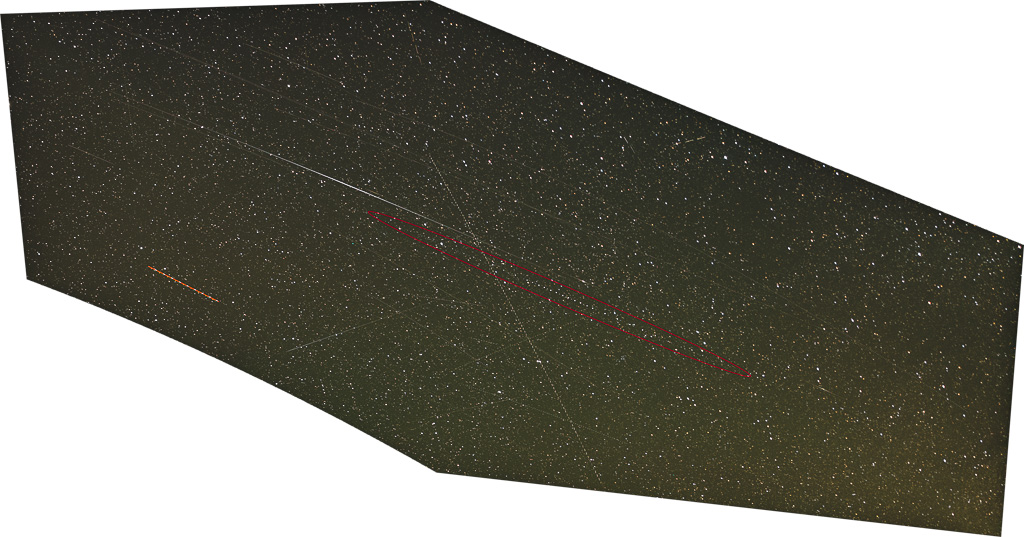
We can now see that there is actually a lot going on in this nearly 2-hour time-frame: An airplane at lower left, a GPS satellite trends from upper-left to lower-right, and notably many roughly parallel lines that are the satellites in the geosynchronous belt, fairly close to each other. Now, let’s recall what we are looking at compared to the star trail image, as it is sort of opposite, now showing relative movement of stationary satellites through the starfield, as the earth rotates. Here is a crop of the center of the image, with the tumbling and/or re-positioning satellite track circled in red; each ‘dot’ of light represents a single exposure, every 11th for the bright reflections of the (presumably) tumbling satellite:
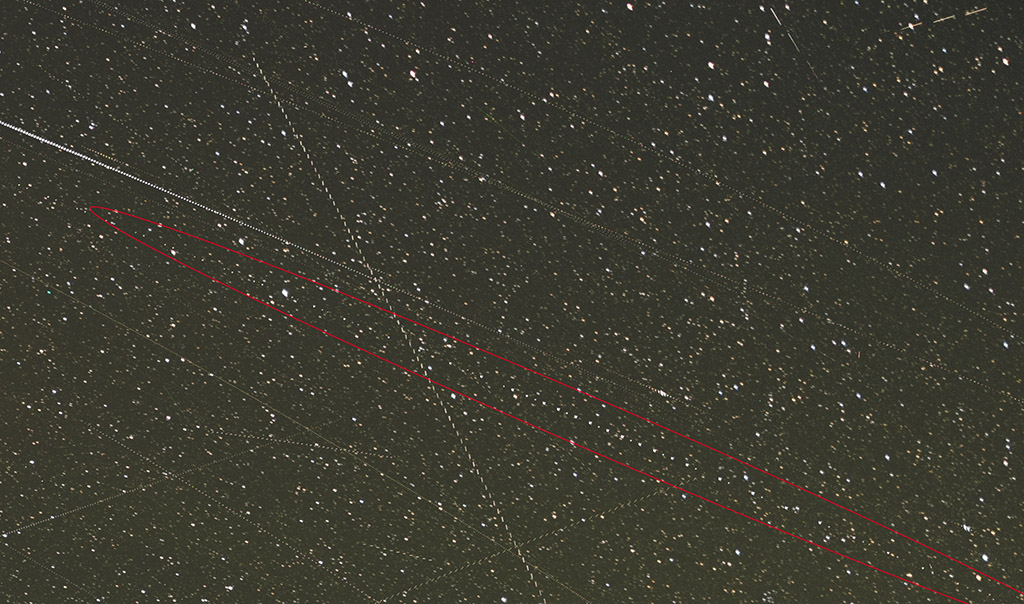
Within the red circle, note the bright points of light that are relatively evenly spaced (though some appear ‘missing’, due to the camera occasionally being in between frames during the flash); in the video, this shows as the periodically ‘flashing’ light (every 2m 34s). This particular view is what (for me) identifies this as a tumbling satellite, as there is a bright central portion, and on either side the ‘flashes’ dim to nearly nothing. This is commonly seen when satellites ‘flare’ when above the sun (which is obviously below the horizon), and you can see that the geosat above the red circle brightens from right to left (also a very small, quick ‘flare’, center-right). This flaring phenomenon occurs due to the sun reflecting off of a satellite’s solar panels (or chassis, in some cases) and is quite common, and is what made the old Iridium satellites flare, sometimes visible even in daytime (the old Iridium constellation has since been decommissioned, de-orbited and replaced with newer spacecraft).
Note that this is only a single occurrence of a geosat flare, in this case one that is likely in an unstable (non-operational, out of control) orbit. There can be single flashes, sets of finite flashes over short periods of time, or flashes recurring over longer periods of time).
Anyway, this is one of the two sources of ‘flashing lights in the sky’ that I have routinely observed, and I will endeavor to document the other type shortly. Apologies for the esoteric explanation, but some things need a bit more detail to explain than others!

